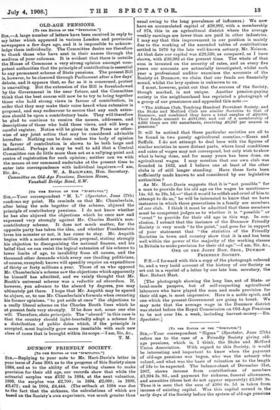[TO TRU EDITOR OF TIM "SPICTATOR."]
SIR,—Your correspondent " Sigma " (Spectator, June 27th) refers me to the case of a Friendly Society giving old- age pensions, which is, I think, the Stoke and Melford Union Association. With regard to this Society, it would be interesting and important to know when the payment of old-age pensions was begun, who was the actuary who valued, and what was the basis of valuation as to the length of life to be expected. The balance-sheet of December 31st, 1907, shows income from contributions of members 21,894 2s. 8d., and payment for sickness, funeral allowances, and annuities (these last do not appear separately) £2,860 9s. Thus it is seen that the sum of £996 6s. 5d. is taken from income of existing capital. Was this capital earned in the early days of the Society before the system of old-age pensions came into being ? But to take a wider view. Let regard be bad to two of the largest Friendly Societies, which number over two million of members as against the nineteen hundred of the Stoke and Melford Association, and cover risks of every class of workers throughout the kingdom, and let it be asked with what success sick and funeral claims alone have been met up to now. The Ancient Order of Foresters at their last valuation in 1902 had a deficiency of 21,924,762. The Man- chester Unity of Oddfellows when last valued showed for the first time in their history a surplus,—but only something over 230,000. With the superadded claim of old-age annuities solvency would be further off than ever. Secessions from these Orders are counted by thousands yearly. In most cases the reason given is that lack of employment and poverty of the members are the cause. If these facts cannot be con- troverted, bow can the workers meet the charge of insurance against old age sCt long as the wages of the majority of them are at so low a level and employment is so uncertain P-1 am,



















































 Previous page
Previous page